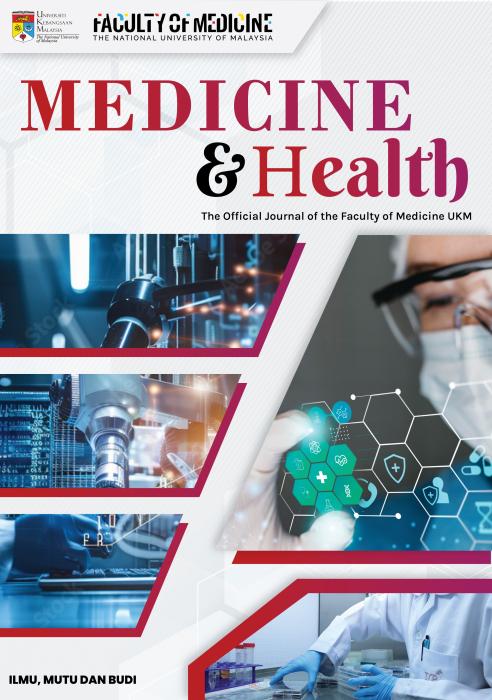Prevalence and Awareness of Lower Urinary Tract Symptoms among Males in the Outpatient Clinics of Universiti Kebangsaan Malaysia Medical Centre
Prevalence and Awareness of Lower Urinary Tract Symptoms among Males in the Outpatient Clinics of Universiti Kebangsaan Malaysia Medical Centre
Abstract
This study aims to determine the prevalence of lower urinary tract symptoms (LUTS) and level of awareness among male outpatients in Universiti Kebangsaan Malaysia Medical Centre (UKMMC). A questionnaire consisting of demographic data, questions related to knowledge, attitude and practice on BPH and the International Prostate Symptom Score (IPSS) was used for this study. Uroflowmetry and bladder scan were used to evaluate the function of the urinary tract and severity of BPH. Urine dipstick was done for glycosuria, proteinuria and haematuria. A total of 220 respondents were surveyed. The prevalence of moderately and severely symptomatic LUTS was 42.7%. The most commonly reported LUTS were nocturia (78.2%), frequency (58.2%) and incomplete emptying (44.6%). The prevalence of glycosuria, proteinuria and haematuria were 23.6%, 11.4% and 1.8% respectively. There was a significant association between increasing age with the severity of LUTS (p=0.005). Out of 102 respondents with voided urine volume greater than 150 mL, there was a significant decrease in maximum (Qmax) (p=0.039) and average (Qave) urine flow rates with every 10 years increase of age (p=0.001). The majority of respondents (59.5%) have heard of BPH before. Over 78.2% of the respondents would seek medical attention if they have LUTS with 15.9% saying they would seek traditional treatment. In conclusion, the prevalence of LUTS was high and the level of awareness was satisfactory.
Keywords :
awareness,
lower urinary tract symptoms,
Malaysia,
prevalence,
prostate,
Abstrak
Kajian ini bertujuan menentukan prevalens simptom trek urinari bawahan (LUTS) dan tahap kesedaran di klinik pesakit luar lelaki di Pusat Perubatan Universiti Kebangsaan Malaysia. Borang soal selidik yang mengandungi data demografi, soalan berkaitan pengetahuan, sikap dan praktis terhadap penyakit pembesaran kelenjar prostat (BPH) dan skor simptom prostat antarabangsa (IPSS) telah digunakan. Alat pengukuran kelajuan kencing dan imbasan pundi kencing digunakan untuk menggambarkan fungsi sistem urinari dan keterukan BPH. “Dipstick” air kencing digunakan untuk menentukan kandungan gula, protein dan darah dalam air kencing. Sejumlah 220 pesakit dikaji. Prevalens LUTS yang sederhana dan teruk adalah 42.7%. Simptom paling kerap ialah kerap kencing waktu malam (78.2%), kerap kencing (58.2%) dan ketidakbolehan mengosongkan pundi kencing sepenuhnya (44.6%). Prevalens gula, protein dan darah dalam kencing ialah 23.6%, 11.4% dan 1.8%. Terdapat hubungan yang signifikan antara peningkatan umur dan keterukan LUTS (p=0.005). Daripada 102 pesakit dengan jumlah air kencing melebihi 150ml, terdapat pengurangan yang signifikan dalam kelajuan maksimum (Qmax) (p=0.039)dan purata kelajuan (Qave) air kencing untuk setiap peningkatan 10 tahun dalam umur (p=0.001). Kebanyakan pesakit (59.5%) pernah dengar tentang BPH. Seramai 78.2% pesakit akan mendapatkan rawatan jika mengidap LUTS sementara 15.9% pula berkata mereka akan mendapatkan rawatan tradisional. Kesimpulannya, prevalens LUTS adalah tinggi dan tahap kesedaran memuaskan.
Kata Kunci :
kesedaran,
Malaysia,
prevalens,
prostat,
simptom trek urinari bawahan,
Correspondance Address
Christopher Ho Chee Kong, Department of Surgery, Faculty of Medicine, Universiti Kebangsaan Malaysia, Jalan Yaacob Latif, Bandar Tun Razak, 56000 Cheras, Kuala Lumpur. Tel: +60126826599. Fax: +60391456684. Email: chrisckho2002@yahoo.com








